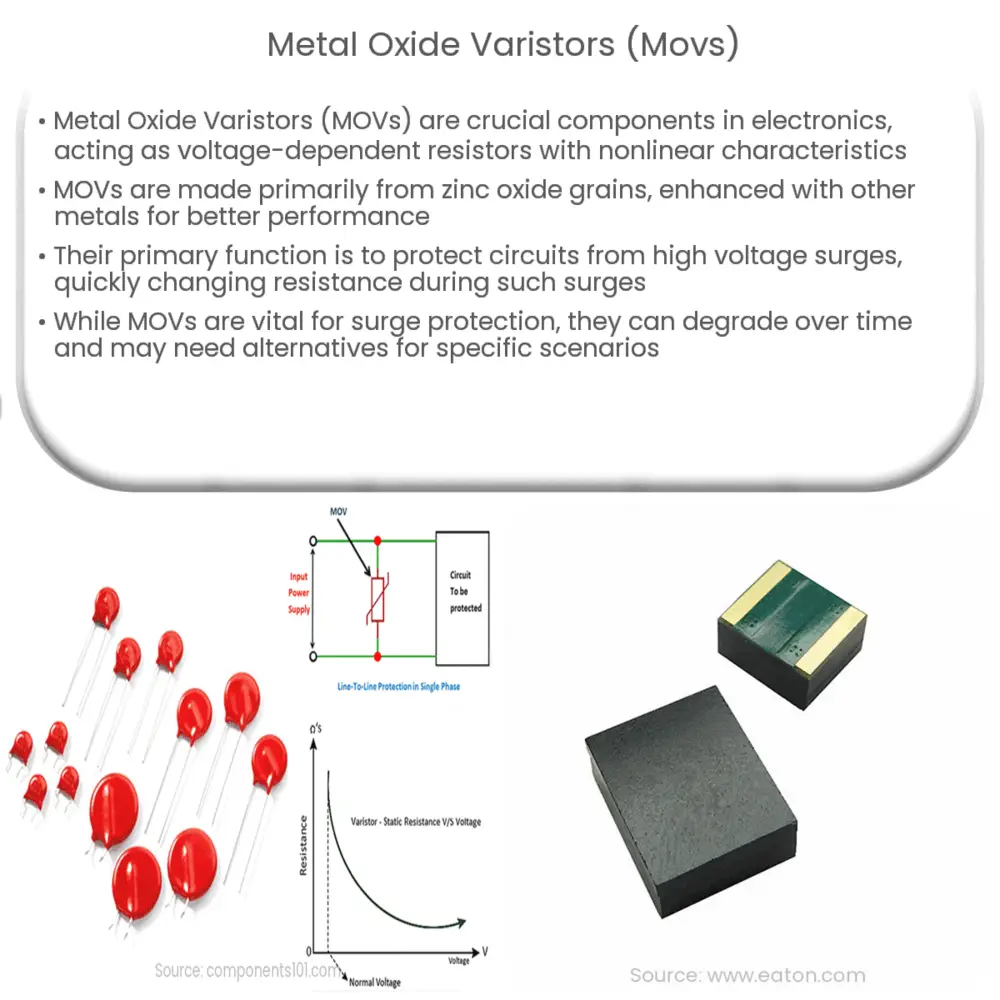Explore the workings of Metal Oxide Varistors (MOVs), their types, applications, and how to choose the right MOV for circuit protection.

Understanding Metal Oxide Varistors (MOVs)
The field of electronics is filled with a vast range of components that each serve unique and critical roles in circuit designs. One such component is the Metal Oxide Varistor (MOV). The MOV is a voltage-dependent resistor with a nonlinear voltage-current characteristic that is symmetrical around zero. But what exactly does this mean and why is it important? Let’s delve deeper.
Principle and Construction
At its core, the Metal Oxide Varistor is a type of resistor – the basic electrical component that regulates the flow of electricity in a circuit. The term ‘varistor’ is a portmanteau of ‘variable resistor’. This implies that unlike typical resistors, the resistance provided by a MOV changes with the applied voltage.
The MOV is primarily constructed from zinc oxide (ZnO) grains, with small amounts of other metal oxides such as bismuth, cobalt, manganese, among others. These additional metals are added to improve the varistor’s performance. The granular structure of the zinc oxide forms a dense, ceramic-like material that contributes to the variable resistance property of the MOV.
How Does a MOV Work?
A Metal Oxide Varistor functions based on its voltage-current characteristics. Under normal conditions, when the voltage across the MOV is below the ‘clamping voltage’ or ‘varistor voltage’, the MOV behaves as a high-resistance component. This means it allows very little current to pass through.
However, when the voltage surpasses the clamping voltage, the resistance of the MOV drops dramatically, allowing a high current to pass through. This property is particularly useful in protecting circuits against high voltage surges, such as those caused by lightning or power spikes. Thus, the MOV serves as a critical protective element in a wide variety of electronic devices.
- Surge Protection: When a voltage surge occurs, the MOV quickly changes its resistance from high to low, diverting the excess voltage away from sensitive components.
- Energy Absorption: The MOV has the ability to absorb and dissipate the energy from voltage surges, preventing damage to the circuit.
Next, we will delve deeper into the different types of MOVs, their applications, and how to choose the right MOV for your needs.
Different Types of MOVs and Their Applications
Metal Oxide Varistors come in several varieties, each designed to cater to specific needs and applications. Some common types include:
- Disc Varistors: These are the most common type of MOVs. They are typically used in power lines, control systems, and surge protection devices.
- SMD Varistors: Short for Surface Mount Device Varistors, these are smaller in size and are usually used in electronics that require compact, space-saving solutions.
- Strap Varistors: These are used in specific applications like photovoltaic systems and wind power generators.
Choosing the Right MOV
When choosing a Metal Oxide Varistor, one of the most critical specifications to consider is the varistor voltage. This voltage should be slightly higher than the maximum normal operating voltage of the circuit to avoid unnecessary activation of the MOV. Another vital factor is the MOV’s energy rating, which should be high enough to handle the energy associated with a voltage surge. Additionally, other parameters like response time, leakage current, and the life expectancy of the MOV should also be considered.
Limitations and Alternatives
While MOVs offer excellent surge protection, they do have limitations. For instance, they are susceptible to degradation over time due to repeated voltage surges. Also, they can be destroyed by high energy transients. In such cases, other protective devices like gas discharge tubes, silicon avalanche diodes, or transient voltage suppressor diodes might be more suitable.
Conclusion
In conclusion, Metal Oxide Varistors play an integral role in protecting electronic circuits from potentially damaging voltage surges. Understanding the basic principles of their operation, their various types, and their application areas can assist in making an informed decision when selecting the appropriate MOV for a specific need. However, it’s equally crucial to understand their limitations and know when alternative devices might be a more suitable choice. The dynamic field of electronics is always evolving, but the basic principles, like those governing the operation of the MOV, remain constant and form the bedrock upon which new technologies and innovations are built.

